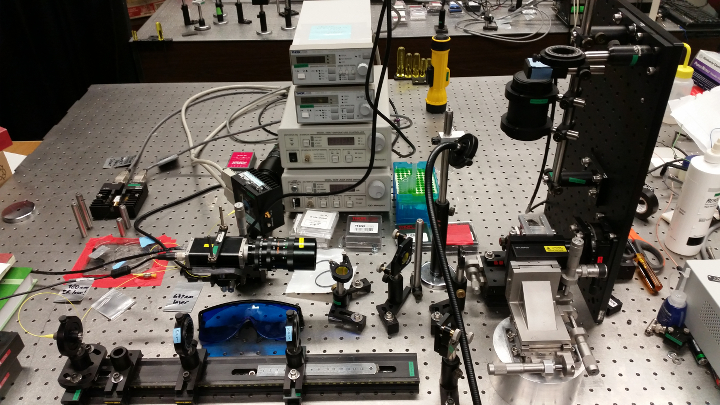Difference between revisions of "Optical Tweezers"
(→Optical Tweezers) |
(→Optical Tweezers) |
||
| Line 80: | Line 80: | ||
<ul> | <ul> | ||
<li> | <li> | ||
| − | [http://www.instructables.com/id/Image-Acquisition-in-NI-Vision-Assistant/] Image Acquisition/Saving Images | + | [http://www.instructables.com/id/Image-Acquisition-in-NI-Vision-Assistant/] Image Acquisition/Saving Images. The UI for this program is rather difficult. To exit from video capture mode after capturing images there is a button that says close near the bottom left, underneath the camera options window. |
</li> | </li> | ||
<li> | <li> | ||
| Line 86: | Line 86: | ||
<ul> | <ul> | ||
<li> | <li> | ||
| − | We actually tried both using pattern matching and brute force point and click methods. Neither worked very well, so we recommend using the QPD to get position measurements | + | To get an actual video, you need to run the pictures through another video editing program. There is one on the computer, but there is no video option in NI Vision Assistant itself. |
| + | </li> | ||
| + | <li> | ||
| + | We actually tried both using pattern matching and brute force point and click methods. Neither worked very well, so we recommend using the QPD to get position measurements. You don't need an actual video for this. | ||
</li> | </li> | ||
</ul> | </ul> | ||
Revision as of 12:32, 10 December 2014
Contents
Optical Tweezers
Background
Scattering Basics - Incident Plane Wave (from Michigan Tech)
Plane wave scattering theory may be used to illustrate gross optical trapping behavior via momentum transfer between the light field and the particle (total momentum is conserved). However, the optical waves employed to trap a particle in a typical optical-tweezers setup are most definitely not planar. For a full description of the scattering process see "Theory of trapping forces in optical tweezers", A. Mazolli, P. A. Maia Neto and H. M. Nussenzveig, Proc. R. Soc. Lond., A 8 December 2003 vol. 459 no. 2040 3021-3041.
When the size parameter , where is the particle radius, is the index of the medium surrounding the particle and is the vacuum wavelength of the trapping light, the results from a geometrical optics treatment holds.
For a geometrical optics treatment see, "Optical tweezers for undergraduates: Theoretical analysis and experiments", M. S. Rocha, Am. J. Phys. 77, 704 (2009).
Example: For a trapping laser of wavelength 635nm and a 2 micron particle in a surrounding medium of water, so the geometrical optics treatment holds and Mie scattering is the dominant trapping process.
More simply, there are two forces in action on a trapped particle, one of which will be more dominant depending on the size of the particle, the wavelength, etc. One of these forces is the transference of momentum by photons, the other force is the attractive force of the electric field gradient. The first acts somewhat like a strong current of water, the second draws the particle up to the highest point of the gradient, the center of the laser.
Resources
Making Diluted Solutions of MicroSpheres
- Summer 2014 Powerpoint[1]
- [2] Directions on how to use a QPD in an optical tweezer setup.
- [3] Here are some slide prepping instructions from Berkeley.
Our own setup
- Slide Setup
- Microscope Slide Mount
-
Stokes' Setup
- Spring 2013 Method (ramped) [4]
-
Summer 2014 Method (sinusoidal)
[5]
- Stoke's Force Calibration Video (sinusoidal)[6]
Using NI Vision Assistant
- [7] Image Acquisition/Saving Images. The UI for this program is rather difficult. To exit from video capture mode after capturing images there is a button that says close near the bottom left, underneath the camera options window.
-
[8] How to track the microspheres in NI Vision Assistant using pattern matching.
- To get an actual video, you need to run the pictures through another video editing program. There is one on the computer, but there is no video option in NI Vision Assistant itself.
- We actually tried both using pattern matching and brute force point and click methods. Neither worked very well, so we recommend using the QPD to get position measurements. You don't need an actual video for this.
Our calculations using Brownian Motion
Calculating Trap Forces Using Stokes' Drag Force
- [11] iPython Calculations
-
Beam Power (mW) Escape Velocity (microns/second) Trap Force (pN) 5.5 20.57 0.44 8.5 33.49 0.72 11.7 40.00 0.86 15.3 62.60 1.34 19.0 84.71 1.82 23.0 110.77 2.38 
- A simple calculation would say that I need a 10 billion watt laser to achieve a 1 Newton trapping force. We should totally do that. The spheres would be so incredibly trapped.
Trapping Video
Performing Biological Measurements
- Installing Infared Laser
- Preparing bacteria to Analyze
- Current Progress and Issues





